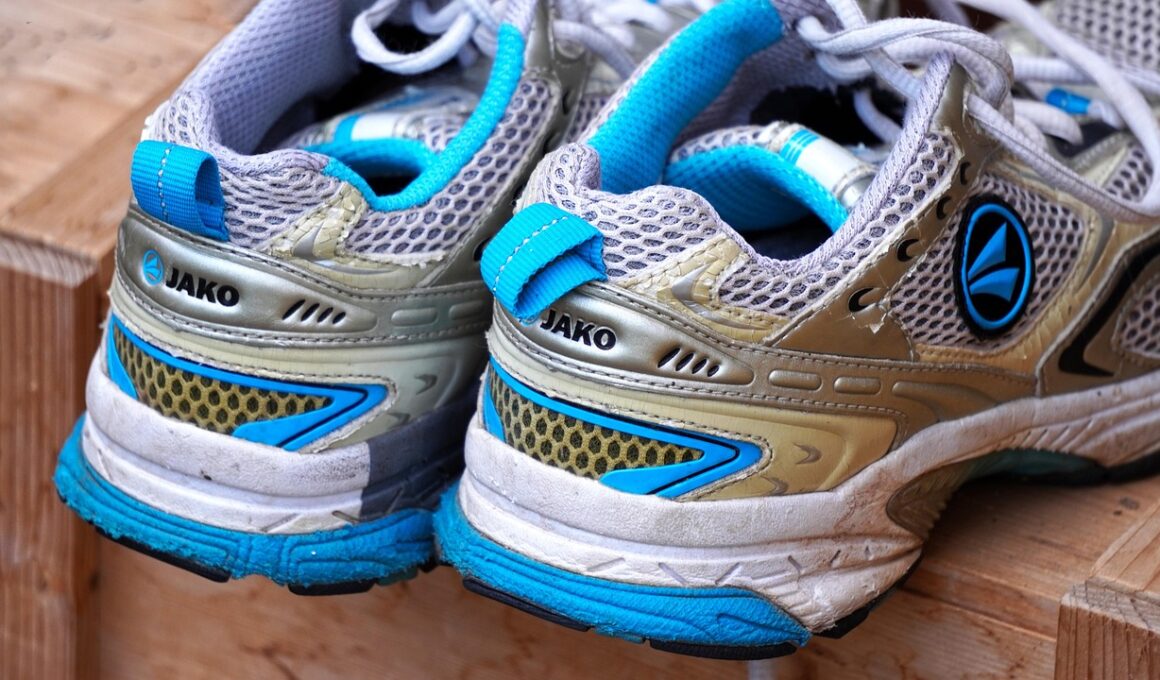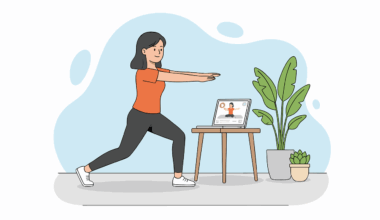Choosing the Right Footwear for Safe Training
Selecting the right footwear is essential for ensuring safety when training at the gym or outdoors. The type of shoes worn can significantly affect performance and injury prevention. Firstly, consider the specific training activity you plan on doing. For instance, running shoes often provide better cushioning and support than regular sneakers. In contrast, shoes designed for weightlifting often come with added stability features, allowing better foot grounding. Additionally, the fit of the shoe is crucial. Shoes that are too tight can lead to blisters and discomfort, while loose shoes can contribute to instability, increasing the risk of injury. Therefore, testing the shoes by walking or jogging in them is highly recommended. Furthermore, assess the shoe’s tread and sole. Good traction can prevent slipping, contributing to safer workouts. Keep an eye out for signs of wear and replace shoes regularly to maintain optimal support and cushioning. Ultimately, the best footwear is one that has been tailored for your specific workout needs, combining comfort, durability, and style to enhance your training experience.
Another important aspect to consider when choosing training footwear is arch support. Many people have different arch types, which can significantly affect comfort and foot mechanics during exercise. Those with flat feet might benefit from shoes with motion control features, which provide extra support and stability. Conversely, individuals with high arches often require shoes with more cushioning to absorb impact better. Understanding one’s foot type is essential in selecting the proper footwear. You can visit specialized stores that offer gait analysis to determine your foot type and find the best shoe recommendations. In addition to arch support, consider the shoe’s weight; overly heavy shoes can tire your feet and legs faster than lighter options. Ventilation is another aspect not to overlook. Proper airflow in footwear allows for cooling and moisture management, essential during intensive training sessions. Choose materials that promote breathability to keep your feet comfortable. Finally, always remember that aesthetics matter too! Shoes that appeal to your style can boost your confidence and motivation during workouts.
Investing in Quality Footwear
Investing in quality footwear is not just about spending more; it’s a commitment to your health and safety. Cheaper shoes often compromise on materials, support, and construction, leading to foot pain and potential injuries over time. Higher-quality brands typically invest in research and technology to develop shoes that enhance performance while protecting your feet. When shopping, it’s wise to look for reputable brands known for their focus on training and sports footwear. Always read reviews and ratings from other users to gain insight into the durability and comfort of the shoes. In addition, consider when to shop for shoes – visiting stores later in the day is advantageous since your feet tend to swell. This way, you can ensure a better fit for the times you’re most active. While price is a factor, remember that the right shoes will prevent injuries, saving you from medical bills and downtime. Therefore, consider quality footwear as an investment in yourself. The right pair can make a significant difference in your training, enhancing both safety and performance.
Alongside purchasing quality footwear, maintaining your shoes is equally important. Shoes should be regularly clean to eliminate dirt and debris, which can degrade the materials over time. Use a damp cloth or brush to clean them after a workout, and avoid machine washing unless specified by the manufacturer’s instructions. Additionally, rotating between two or more pairs of shoes can help extend their lifespan and provide a more comfortable fit by ensuring adequate recovery time for the cushioning. Furthermore, always check the soles for wear and tear; if you notice uneven tread patterns or noticeable wear, it’s time to replace them. Properly storing shoes is crucial too. Keep them in a cool, dry place away from direct sunlight which could deteriorate materials. Pay attention to how they smell as well; odor suggests moisture build-up, indicating it’s time to air them out or use insoles designed for odor control. By maintaining your shoes well, you are preserving the protective features essential for safe training and enhancing your overall workout experience.
Testing Footwear Before Purchase
Before committing to a pair of shoes, it’s wise to put them to the test. Walking around the store while trying shoes can give you a better feel for comfort and fit. Many stores cater to sports enthusiasts with treadmills or tracks for this very purpose. Testing shoes can help evaluate arch support and cushioning under different scenarios. Don’t hesitate to run or jump slightly to see how the shoes respond; the right footwear should feel like an extension of your foot, not restrictive. Additionally, take your time; if possible, try on shoes at various times of the day or during less busy hours to avoid feeling rushed in making a purchase decision. Pay attention to the return policy as well; some stores allow returns on used shoes, which can provide peace of mind. It’s also helpful to use online resources; many online retailers have detailed sizing charts and customer feedback to guide your choice. Researching your options and ensuring the fit is correct is critical for safely enjoying your training endeavors.
Finally, regularly evaluate your footwear needs, as your training routine and foot shape can change over time. Your shoes should align not only with the types of workouts but also with the intensity levels you achieve. Different training seasons may require different types of shoes; for example, running shoes may suffice for moderate jogging, but higher-intensity workouts can demand more specialized footwear. Be mindful of body signals — discomfort or pain can indicate it’s time for a shoe change, as signifying gradual wear. Keeping track of mileage can also help in determining shoe viability; if you notice a change in comfort levels or performance, don’t hesitate to buy new ones. Make it a habit to inspect your shoes regularly. Additionally, involving professionals when selecting shoes or evaluating their performance can elevate safety levels. Always prioritize your comfort and safety during any physical activities. Ultimately, footwear plays a pivotal role in your performance and injury prevention, so never take the decision lightly.
Conclusion: The Importance of Proper Footwear
In conclusion, the significance of choosing the right footwear cannot be overstated when it comes to training safety. Proper shoes support foot health and improve training performance and motivation levels. Prioritize essential aspects like fit, arch support, cushioning, breathability, and style to ensure that you make a well-rounded choice. Quality shoes are an investment in injury prevention and enhanced training outcomes. Regular maintenance and proactivity in evaluating your footwear needs can contribute to overall physical health and longevity in your training journey. Keep testing and adapting your footwear as necessary to align with changing activities or any physical changes. When it comes down to effective and safe workouts, the right shoes can be game-changers; they ensure comfort, stability, and protection. Embrace the essential role of footwear in your fitness routine, allowing you to engage fully in your activities with confidence and safety.


